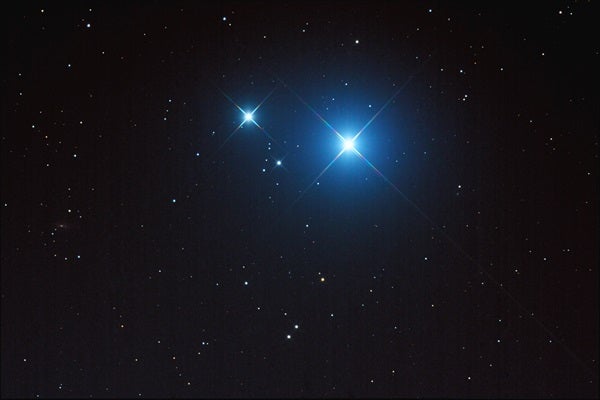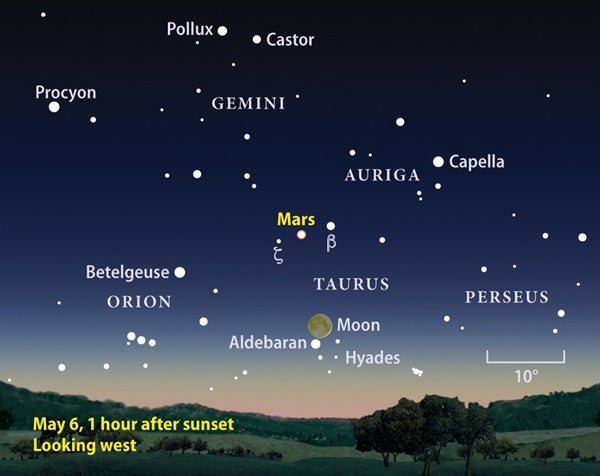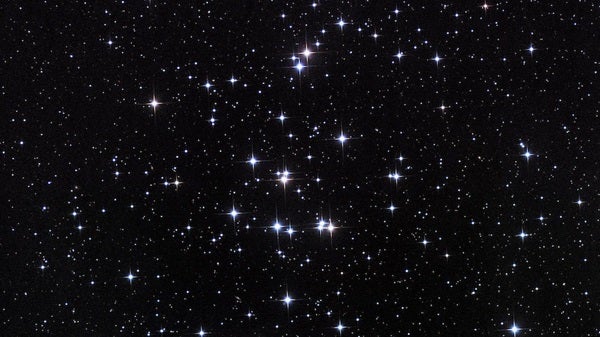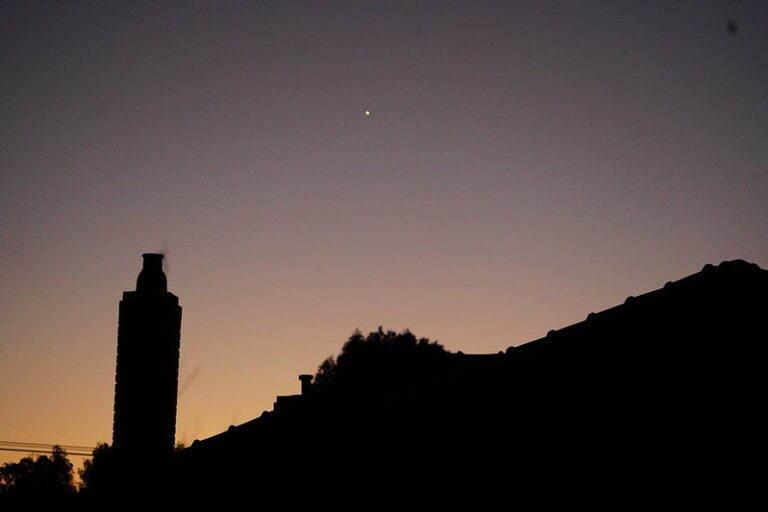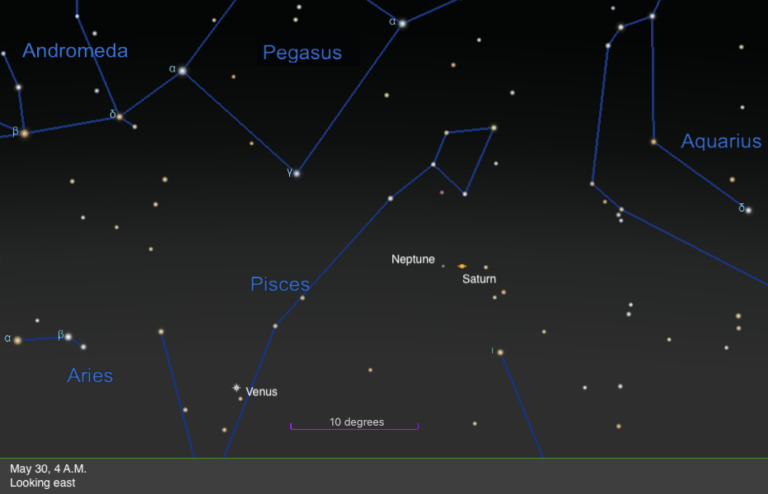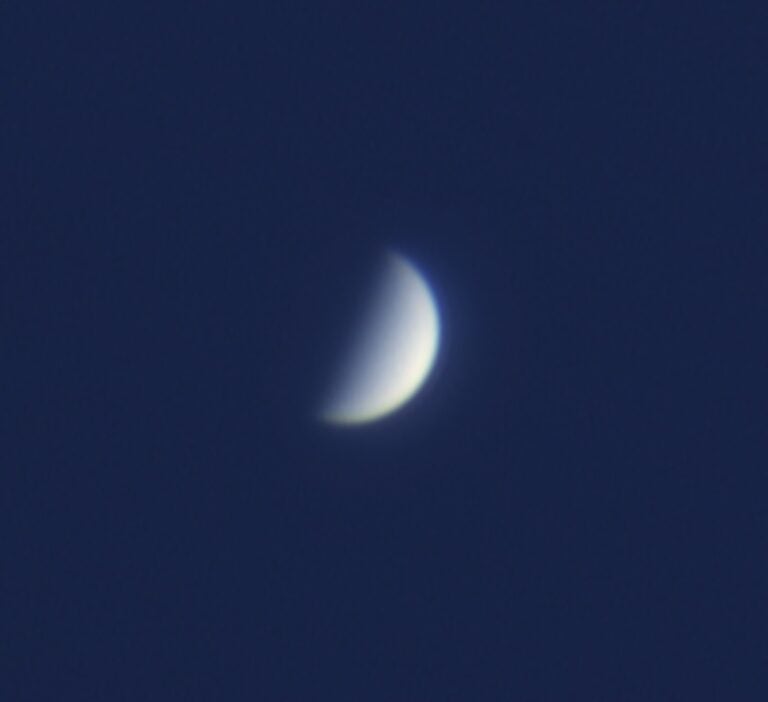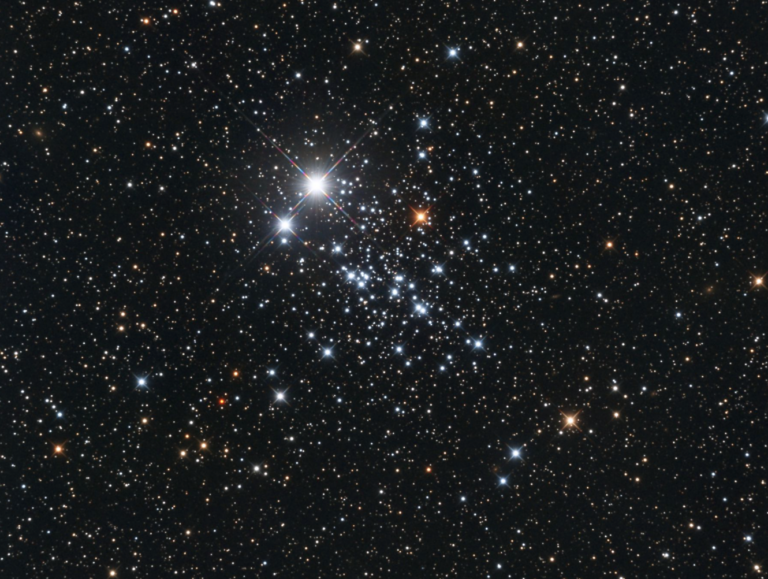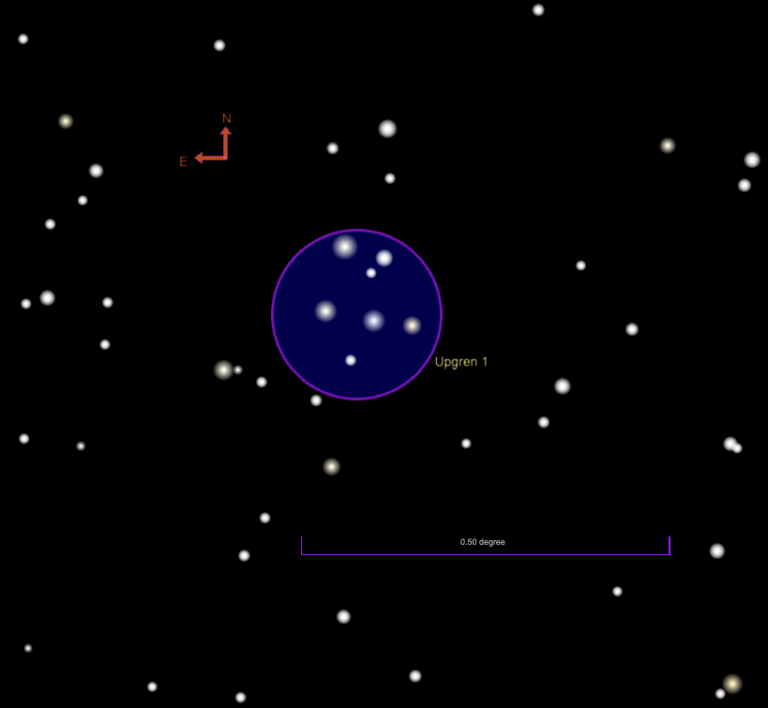Although the calendar says May, the Summer Triangle returns to prominence this month. The asterism’s three bright stars — Vega in Lyra, Deneb in Cygnus, and Altair in Aquila — all clear the horizon by midnight local daylight time. An hour later, they rule the eastern sky. Vega shines brightest and appears at the apex of the triangular asterism. Look for Deneb to Vega’s lower left and Altair to the lower right of the other two. The Summer Triangle will grace the Northern Hemisphere’s evening sky from now through the end of the year.
Saturday, May 4
Head outside late this evening and you can’t miss Jupiter. The giant planet rises shortly after 11 p.m. local daylight time and climbs highest in the south around 4 a.m. Jupiter shines at magnitude –2.5, which makes it the brightest point of light in the sky until Venus rises during twilight. The planet currently resides among the much dimmer stars of the constellation Ophiuchus. A telescope reveals the gas giant’s 44″-diameter disk and four bright moons.
New Moon occurs at 6:46 p.m. EDT. At its New phase, the Moon crosses the sky with the Sun and so remains hidden in our star’s glare.
Sunday, May 5
One of this year’s best meteor showers reaches its peak before dawn tomorrow morning. The Eta Aquariid shower derives from bits of debris ejected by Comet 1P/Halley during its many trips around the Sun. When Earth crosses this debris stream, our planet’s atmosphere incinerates the tiny dust particles and we see the streaks of light called meteors, or “shooting stars.” Shortly before dawn, an observer at a dark site can expect to see up to 20 meteors per hour — an average of one every three minutes. Viewers in the Southern Hemisphere, where the shower’s radiant (in the constellation Aquarius) passes nearly overhead, should see twice as many. And with the Moon having reached its New phase yesterday, conditions should be ideal.
Mars continues to add its ruby-red glow to Taurus the Bull this week. Shining at magnitude 1.7, the Red Planet appears slightly fainter than the constellation’s brightest star, ruddy 1st-magnitude Aldebaran. The planet lies nearly 25° above the western horizon an hour after sundown and doesn’t set until after 11 p.m. local daylight time. As the sky darkens, you should notice that Mars is nestled between the Bull’s two horns — Beta (β) and Zeta (ζ) Tauri — making it look as though Taurus has sprouted a third one. Beta shines as brightly as Mars while Zeta appears 1.3 magnitudes fainter than the other two. Adding to the scene is a slender crescent Moon perched just above the Hyades star cluster, which forms the Bull’s face.
Tuesday, May 7
A slightly fatter crescent Moon slides 3° south (lower left) of Mars this evening. And for a few lucky observers, the Moon’s limb will graze Zeta (ζ) Tauri. Those positioned along a narrow path that stretches from Wichita, Kansas, to Savannah, Georgia, can see the 3rd-magnitude star disappear behind mountains and reappear in valleys along Luna’s northern edge. Observers with clear skies south of this line can witness a total occultation while those north of the line will see the Moon barely miss the star.
Wednesday, May 8
The Big Dipper’s familiar shape rides high in the north on May evenings. The spring sky’s finest binocular double star marks the bend of the Dipper’s handle. Mizar shines at 2nd magnitude, some six times brighter than its 4th-magnitude companion, Alcor. Even though these two are not physically related, they make a fine sight through binoculars. (People with good eyesight often can split the pair without optical aid.) A small telescope reveals Mizar itself as double — and these components do orbit each other.
Thursday, May 9
Venus pokes above the eastern horizon about an hour before sunrise. The brilliant planet dominates the predawn sky as the rosy glow heralding the Sun’s arrival grows brighter. Venus shines at magnitude –3.8, more than three times brighter than the second-brightest planet, Jupiter. When viewed through a telescope, the inner world shows a disk that spans 11″ and appears 90 percent lit.
The Moon appears as a fat crescent this evening as it plunges through the Beehive star cluster (M44) in Cancer the Crab. Observers in the eastern half of North America have the chance to see dozens of stars disappear behind the Moon’s advancing dark limb, with most of the action occurring between 10 and 11 p.m. EDT. A telescope allows viewers to watch individual occultations while binoculars nicely capture the overall scene.
Saturday, May 11
First Quarter Moon arrives at 9:12 p.m. EDT. The half-lit orb rises around noon local daylight time, appears high in the southwest as darkness falls, and sets around 2 a.m. tomorrow morning. The Moon spends the night among the background stars of western Leo the Lion.
Sunday, May 12
Saturn grows more conspicuous in the morning sky with each passing week. The ringed planet rises by 12:30 a.m. local daylight time and climbs 25° high in the south-southeast as twilight begins. Saturn shines at magnitude 0.4 and appears significantly brighter than any of the background stars in its host constellation, Sagittarius the Archer. A telescope shows the gas giant’s 18″-diameter disk and a spectacular ring system that spans 40″ and tilts 24° to our line of sight.

